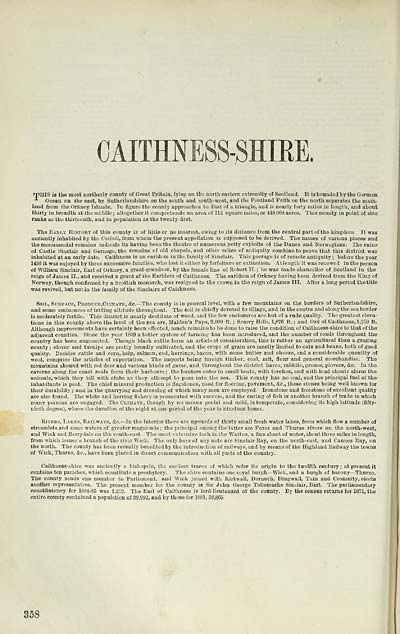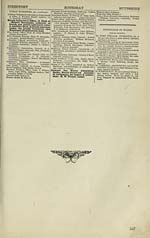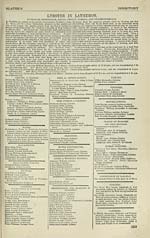Scotland > 1882-1915 - Slater's Royal National Commercial Directory of Scotland > 1886 - Slater's (late Pigot and Co's) Royal national commercial directory and topography of Scotland
(1022)
Download files
Complete book:
Individual page:
Thumbnail gallery: Grid view | List view

CAITHNESS-SHIRE.
rpHIS is the most northerly county of Great Britain, lying on the north-eastern extremity of Scotland. It is bounded by the German
Ocean on the east, by Sutherlandshire on the south and south- west, and the Pentland Frith on the north separates the main-
land from the Orkney Islands. In figure the county approaches to that of a triangle, and is nearly forty miles in length, and about
thirty in breadth at the middle ; altogether it comprehends an area of 712 square miles, or 448,068 acres. This county in point of size
ranks as the thirteenth, and in population as the twenty-first.
The Early History of this county is of little or no interest, owing to its distance from the central part of the kingdom. It was
anciently inhabited by the Catinii, from whom the present appellation is supposed to be derived. The names of various places and
the monumental remains indicate its having been the theatre of numerous petty exploits of the Danes and Norwegians. The ruins
of Castle Sinclair and Gernego.the remains of old chapels, and other relics of antiquity combine to prove that this district was
inhabited at an early date. Caithness is an earldom in the family of Sinclair. This peerage is of remote antiquity ; before the year
1450 it was enjoyed by three successive families, who lost it either by forfeiture or extinction. Atlength it was renewed in the person
of William Sinclair, Earl of Orkney, a great-grandson, by the female line of Robert II. ; he was made chancellor of Scotland in the
reign of James II., and received a grant of the Earldom of Caithness. The earldom of Orkney having been derived from the King of
Norway, though confirmed by a Scottish monarch, was resigned to the crown in the reign of James III. After a long period the title
was revived, but not in the family of the Sinclairs of Caichness.
Soil, Surface, Produce.Climate, &c— The county is in general level, with a few mountains on the borders of Sutherlandshire,
and some eminences of trifling altitude throughout. The soil is chiefly devoted to tillage, and in the centre and along the sea border
is moderately fertile. This district is nearly destitute of wood, and the few enclosures are but of a rude quality. The greatest eleva-
tions in this county above the level of the sea are, Maiden's Paps, 2,000 ft. ; Scarry Hills, 1,876 ft. ; and Ord of Caithness, 1,250 ft.
Although improvements have certainly been effected, much remains to be done to raise the condition of Caithness-shire to that of the
adjacent counties. Since the year 1809 a better system of farming has been introduced, and the number of roads throughout the
country has been augmented. Though black cattle form an article of consideration, this is rather an agricultural than a grazing
county ; clover and turnips are pretty broadly cultivated, and the crops of grain are mostly limited to oats and beans, both of good
quality. Besides cattle and corn, kelp, salmon, cod, herrings, bacon, with some butter and cheese, and a considerable quantity of
wool, comprise the articles of exportation. The imports being foreign timber, coal, salt, flour and general merchandise. The
mountains abound with red deer and various kinds of game, and throughout the district hares, rabbits, grouse, plovers, &c. In tho
caverns along the coast seals form their harbours ; the hunters enter in small boats, with torches, and with loud shouts alarm tho
animals, which they kill with clubs as they attempt to pass into the sea. This county has no coal, and the principal fuel of tho
inhabitants is peat. The chief mineral production is flagstones, used for flooring, pavement, &c, these stones being well known for
their durability ; and in the quarrying and dressing of which many men are employed- Ironstone and freestone of excellent quality
are also found. The white and herring fishery is prosecuted with success, and the curing of fish is another branch of trade in which
many persons are engaged. The Climate, though by no means genial and mild, is temperate, considering its high latitude (fifty-
ninth degree), where the duration of the night at one period of the year is nineteen hours.
Rivers, Laees, Railways, &c— In the interior there are upwards of thirty small fresh water lakes, from which flow a number of
Btreamlets and some waters of greater magnitude ; the principal among thelatter are Forss and Thurso rivers on the north-west,
and Wick and Berrydale on the south-east. The most extensive loch is the Watten, a fine sheet of water, about three miles in length,
from which issues a branch of the river Wick. The only bays of any note are Sinclair Bay, on the north-east, and Cannes Bay, on
the north. The county has been recently benefited by the introduction of railways, and by means of the Highland Railway the towns
of Wick, Thurso, &c, have been placed in direct communication with all parts of tho country.
Caithness-shire was anciently a bishopric, the earliest traces of which refer its origin to the twelfth century; at present it
contains ten parishes, which constitute a presbytery. The shire contains one royal burgh— Wick, and a burgh of barony — Thurso.
The county sends one member to Parliament, and Wick joined with Kirkwall, Dornoch, Dingwall, Tain and Cromarty, elects
another representative. The present member for the county is Sir John George Tollemache Sinclair, Bart. The parliamentary
constitutency for 1884-85 was 1,253. The Earl of Caithness is lord-lieutenant of the county. By the census returns for 1871, the
entire county contained a population of 39,992, and by those for 1881, 38,865
358
rpHIS is the most northerly county of Great Britain, lying on the north-eastern extremity of Scotland. It is bounded by the German
Ocean on the east, by Sutherlandshire on the south and south- west, and the Pentland Frith on the north separates the main-
land from the Orkney Islands. In figure the county approaches to that of a triangle, and is nearly forty miles in length, and about
thirty in breadth at the middle ; altogether it comprehends an area of 712 square miles, or 448,068 acres. This county in point of size
ranks as the thirteenth, and in population as the twenty-first.
The Early History of this county is of little or no interest, owing to its distance from the central part of the kingdom. It was
anciently inhabited by the Catinii, from whom the present appellation is supposed to be derived. The names of various places and
the monumental remains indicate its having been the theatre of numerous petty exploits of the Danes and Norwegians. The ruins
of Castle Sinclair and Gernego.the remains of old chapels, and other relics of antiquity combine to prove that this district was
inhabited at an early date. Caithness is an earldom in the family of Sinclair. This peerage is of remote antiquity ; before the year
1450 it was enjoyed by three successive families, who lost it either by forfeiture or extinction. Atlength it was renewed in the person
of William Sinclair, Earl of Orkney, a great-grandson, by the female line of Robert II. ; he was made chancellor of Scotland in the
reign of James II., and received a grant of the Earldom of Caithness. The earldom of Orkney having been derived from the King of
Norway, though confirmed by a Scottish monarch, was resigned to the crown in the reign of James III. After a long period the title
was revived, but not in the family of the Sinclairs of Caichness.
Soil, Surface, Produce.Climate, &c— The county is in general level, with a few mountains on the borders of Sutherlandshire,
and some eminences of trifling altitude throughout. The soil is chiefly devoted to tillage, and in the centre and along the sea border
is moderately fertile. This district is nearly destitute of wood, and the few enclosures are but of a rude quality. The greatest eleva-
tions in this county above the level of the sea are, Maiden's Paps, 2,000 ft. ; Scarry Hills, 1,876 ft. ; and Ord of Caithness, 1,250 ft.
Although improvements have certainly been effected, much remains to be done to raise the condition of Caithness-shire to that of the
adjacent counties. Since the year 1809 a better system of farming has been introduced, and the number of roads throughout the
country has been augmented. Though black cattle form an article of consideration, this is rather an agricultural than a grazing
county ; clover and turnips are pretty broadly cultivated, and the crops of grain are mostly limited to oats and beans, both of good
quality. Besides cattle and corn, kelp, salmon, cod, herrings, bacon, with some butter and cheese, and a considerable quantity of
wool, comprise the articles of exportation. The imports being foreign timber, coal, salt, flour and general merchandise. The
mountains abound with red deer and various kinds of game, and throughout the district hares, rabbits, grouse, plovers, &c. In tho
caverns along the coast seals form their harbours ; the hunters enter in small boats, with torches, and with loud shouts alarm tho
animals, which they kill with clubs as they attempt to pass into the sea. This county has no coal, and the principal fuel of tho
inhabitants is peat. The chief mineral production is flagstones, used for flooring, pavement, &c, these stones being well known for
their durability ; and in the quarrying and dressing of which many men are employed- Ironstone and freestone of excellent quality
are also found. The white and herring fishery is prosecuted with success, and the curing of fish is another branch of trade in which
many persons are engaged. The Climate, though by no means genial and mild, is temperate, considering its high latitude (fifty-
ninth degree), where the duration of the night at one period of the year is nineteen hours.
Rivers, Laees, Railways, &c— In the interior there are upwards of thirty small fresh water lakes, from which flow a number of
Btreamlets and some waters of greater magnitude ; the principal among thelatter are Forss and Thurso rivers on the north-west,
and Wick and Berrydale on the south-east. The most extensive loch is the Watten, a fine sheet of water, about three miles in length,
from which issues a branch of the river Wick. The only bays of any note are Sinclair Bay, on the north-east, and Cannes Bay, on
the north. The county has been recently benefited by the introduction of railways, and by means of the Highland Railway the towns
of Wick, Thurso, &c, have been placed in direct communication with all parts of tho country.
Caithness-shire was anciently a bishopric, the earliest traces of which refer its origin to the twelfth century; at present it
contains ten parishes, which constitute a presbytery. The shire contains one royal burgh— Wick, and a burgh of barony — Thurso.
The county sends one member to Parliament, and Wick joined with Kirkwall, Dornoch, Dingwall, Tain and Cromarty, elects
another representative. The present member for the county is Sir John George Tollemache Sinclair, Bart. The parliamentary
constitutency for 1884-85 was 1,253. The Earl of Caithness is lord-lieutenant of the county. By the census returns for 1871, the
entire county contained a population of 39,992, and by those for 1881, 38,865
358
Set display mode to: Large image | Transcription
Images and transcriptions on this page, including medium image downloads, may be used under the Creative Commons Attribution 4.0 International Licence unless otherwise stated. ![]()
| Permanent URL | https://digital.nls.uk/90655688 |
|---|
| Description | Directories of the whole, or large parts of, Scotland. |
|---|
| Description | Around 700 Scottish directories published annually by the Post Office or private publishers between 1773 and 1911. Most of Scotland covered, with a focus on Edinburgh, Glasgow, Dundee and Aberdeen. Most volumes include a general directory (A-Z by surname), street directory (A-Z by street) and trade directory (A-Z by trade). |
|---|


